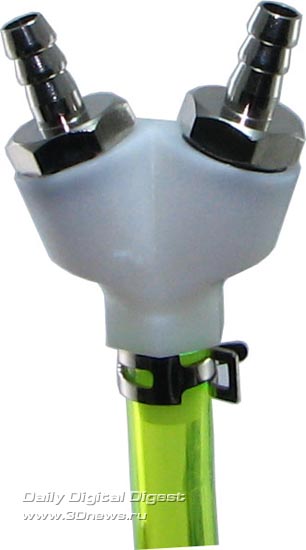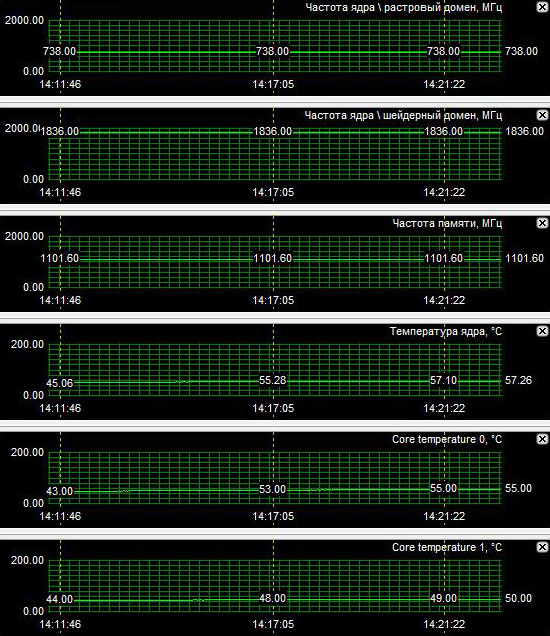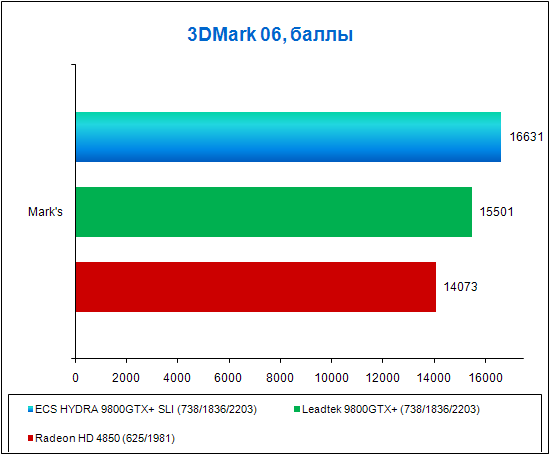All you need to know about your products!

| 3DNews Vendor Reference English Resource - All you need to know about your products! |
||||||
 |
||||||
|
|
||||||
ECS HYDRA GeForce 9800GTX+. Water-cooled and SLI "all-in-one"Author:Date: 31/12/2008 On the front side the box for ECS HYDRA GeForce 9800GTX+, there is an image of a three-headed dragon. This design has turned typical for video cards by ECS, but is contrary to the name of a specific model. However, a hydra like a dragon is a mythical creature with as many heads. On the reverse side of the box for ECS HYDRA GeForce 9800GTX+, displayed are the key specifications and advantages of ECS HYDRA GeForce 9800GTX+ SLI. Since the delivery set of ECS HYDRA GeForce 9800GTX+ includes two video cards and a water-powered cooling system, the package bundle has proved to be quite impressive, so we divided it into two groups. The first group includes the following:
Above listed are quite standard items for a typical bundle of a regular video card (although in doubled quantities), and the most interesting was left to the second group. The second group includes the following items:
As we already stated, ECS HYDRA GeForce 9800GTX+ is made up of two video cards GeForce 9800GTX+ equipped with the water-powered cooling system Thermaltake Bigwater 760i. The advantages of the ECS kit are in that the video cards are already equipped with water blocks and radiators for the power supply subsystem items. Let's get down to the assembly. We first fit the mono block. The task is not easy - we not only have to squeeze it into the housing but install it so as to provide a flow of fresh air to the fan leaving air space at the bottom of the mono block where the heated air could be dissolved. The mono block takes up two 5.25’ compartments, which complicates the task. We decided that in our housing with four 5.25’ compartments the most optimum layout of the mono block would be in the second and third compartments at the top, immediately under the DVD-ROM drive, which we positioned in the first compartment at the top. Then we fitted the video cards and plugged in the unions of water blocks to the pipes of the mono block. At the ends of the nipples, the manufacturer fitted the "IN" and "OUT" tags, so they need to be linked in the right way. Prior to connecting the nipples, metal clamps from the bundle had to be put on them, and on linking the nipples the clamps have to be moved to the connection points to press with pliers.  There is a two-part joint that allows linking the nipples of the water blocks to the single pipe of the mono block. Now that the system has been assembled and plugged in to the power supply unit, special greenish fluid taken from the bundle has to be pored into it. We fitted the mono block on the very top of the housing, so it is not easy to get the lid of the reservoir, let alone having to pour the fluid inside. To do that, there is a special bottle syringe with a hose (see the photo on the left). Since it is soft and easy to squeeze, the fluid can be pumped to the reservoir. That is done is several stages and in between of the stages you have to power on the computer and let the pump of the mono block feed the fluid of the reservoir to the system. Once the hoses and water block of the video cards are filled with the fluid, what is left is to add the fluid up to the right level and tighten the plug. Note that most part of the bottle fluid is spent per system. Once the system is filled with the fluid, we link the video cards with the bundled SLI bridge. The assembled system looks like this: The water block of each video card is equipped with a fan having blue illumination. The mono block is also equipped with blue illumination. Tests of ECS HYDRA GeForce 9800GTX+ video cards for heating and overclockingThe systems of fluid-powered cooling should be more efficient and/or quieter than the traditional air cooling systems. Just think of it - why spend extra efforts, time, and money? The ECS HYDRA GeForce 9800GTX+ system has proved to be quite noisy, which is expectable. Two fans on the video cards and one on the mono block are unlikely to be quiet. Especially in view of the fact that a large amount of air has to be fed through the radiator of the mono block to cool it down. At the same time, the mono block is positioned inside the PC housing, therefore, the radiator will be cooled by pre-heated air and not the outer air of the room temperature. In fact, the mono block should have been brought outside the housing, but the manufacturer has not provided for that. The rotational speed of the fan installed on the mono block is adjustable, for which there is a variable resistor near the supply cable. At the minimum speed, the noise of the fan is acceptable, and becomes to irritate the ear at the maximum speed. On measuring the heating of video cards at the maximum and minimum rotational speeds of the mono block, we found out that even at the minimum speed the video cards are cooled well enough. See for yourselves:  At the maximum speed of the fan in the mono block, the upper video card in the system heated up to 57 degrees. Note that the heating of the upper video video card will be higher since it is heated by the second video card from below.  At the minimum speed of the fan in the mono block, the upper video card heated up to 60 C, which is merely 3 degrees higher than in the previous case. Note that the heating of the video cards was done with FUR Renderer Benchmark 1.4.0 in the mode of testing for stability at 1920x1200 and 8X FSAA enabled. As regards the overclocking, ECS HYDRA GeForce 9800GTX+ overclocked synchronously to 848/2052 MHz for the GPU. We were unable to overclock the video memory, and its frequency remained at 2203 MHz DDR. What is left to find out is the results in terms of overclocking and temperatures which GeForce 9800GTX+ will demonstrate with the air-powered cooling system. For that, we took Leadtek WinFast PX9800 GTX+. Leadtek WinFast PX9800 GTX+Leadtek WinFast PX9800 GTX+ is the most regular GeForce 9800GTX+ video card manufactured following the reference design. WinFast PX9800 GTX+ is shipped in an orange box of pearl glitter, which is customary for Leadtek. Its appearance has not undergone substantial changes as compared to previous models of video cards by this company. The package bundle of Leadtek WinFast PX9800 GTX+ includes the following items:
Externally, Leadtek WinFast PX9800 GTX+ makes no difference from the old GeForce 9800GTX. The major distinction of GeForce 9800GTX+ from GeForce 9800GTX is in the renovated GPU G92 which is now manufactured following the 55 nm process technology. Due to the finer process, NVIDIA has succeeded in raising the clock speeds of GeForce 9800GTX+ video cards. Note that ECS HYDRA GeForce 9800GTX+ comes bundled with absolutely the same video cards with the only difference that instead of the air cooling system it uses a fluid-powered cooling system.  G92 chips made following the 55-nm process are of revision B1. The architecture of new G92 chips makes no difference from that of the older G92 chips made following the 65-nm technology.  The memory chips installed on Leadtek WinFast PX9800 GTX+ are made by Hynix and offer 0.8 ns access time, which is equivalent to the effective clock speed 2400 MHz. The cooling system in GeForce 9800GTX+ also makes no difference from that used in GeForce 9800GTX video cards. Tests of Leadtek WinFast PX9800 GTX+ for heating and overclockingWe note that the system of air cooling for Leadtek WinFast PX9800 GTX+ proved to be quieter than the system of fluid-powered cooling on ECS HYDRA GeForce 9800GTX+ video cards. Of course, that does not apply to all the other GeForce 9800GTX+ video cards made following the reference design. But we should not forget that ECS HYDRA GeForce 9800GTX+ comes bundled with two video cards. But as the experience suggests, two GeForce 9800GTX+ video cards with an air-cooling system which are manufactured following the reference design will be quieter than the ECS HYDRA GeForce 9800GTX+ kit. Now let's see how hotter the Leadtek WinFast PX9800 GTX+ will prove as compared to the counterparts from the ECS HYDRA GeForce 9800GTX+ kit.  Leadtek WinFast PX9800 GTX+ was heated by 10 degrees higher than the video card from the ECS HYDRA GeForce 9800GTX+ kit. We'll be able making the final conclusion regarding the fluid-powered cooling only after comparing the overclocking results for ECS HYDRA GeForce 9800GTX+ versus the overclocking results for Leadtek WinFast PX9800 GTX+. Therefore, Leadtek WinFast PX9800 GTX+ was overclocked to 848/1998 MHz for the GPU. Its video memory like that for ECS HYDRA GeForce 9800GTX+ wouldn't overclock, so we had to leave it at 2203 "effective" MHz. In the end, the shader domain of ECS HYDRA GeForce 9800GTX+ video cards was overclocked to a point merely 50 MHz higher than that for Leadtek WinFast PX9800 GTX+. As it was in the previous case, the heating of the video cards was done with FUR Renderer Benchmark 1.4.0 in the mode of testing for stability at 1920x1200 and 8X FSAA enabled. Testing the speed of the video cardsWe used the following test configuration:
Note that for ECS HYDRA GeForce 9800GTX+ video cards you should use a motherboard with support for SLI. Apart from ECS HYDRA GeForce 9800GTX+ video cards which will be tested only in the SLI mode and Leadtek WinFast PX9800 GTX+ video cards, in our tests we'll be testing Radeon HD 4850. All is simple - Radeon HD 4850 costs as much as one GeForce 9800GTX+. According to the price factor, we should have added GeForce GTX 280 and Radeon HD 4870 X2 into the tests. Right you are - the ECS HYDRA GeForce 9800GTX+ kit should offer a price close to these two video cards. But on the moment of running the tests we had no these video cards on hands, and it turned out that their tests would be redundant. We'll find that out from the results that we produced. To test GeForce 9800GTX+, we used the drivers GeForce 178.24, for Radeon HD 4850 - we used Catalyst 8.10. We start introduction to the results with 3DMark tests.  At the 3DMark 06 suite, the combination of ECS HYDRA GeForce 9800GTX+ SLI was not much faster than the single Leadtek WinFast PX9800 GTX+. This result is related to the boundedness of results from the side of the CPU in this outdated test.    At 3DMark Vantage, in all the three modes the indisputable leader is ECS HYDRA GeForce 9800GTX+ SLI. Despite the raised clock speeds, as compared to the old GeForce 9800GTX, the video card Leadtek WinFast PX9800 GTX+ proved to be slower at this test than Radeon HD 4850. Then we bring in gaming tests which we ran with the 4X FSAA and 16X AF enabled. They will put all the dots on "i's".  At Call of Duty 4, the combination of ECS HYDRA GeForce 9800GTX+ SLI showed itself from the good side through demonstration of a substantial performance gain as compared to the single Leadtek WinFast PX9800 GTX+. The latter proved to be faster than Radeon HD 4850 due to the new drivers and increased frequencies of the renovated GeForce 9800GTX+.  At Need for Speed Pro Street Racing, we also found no complaints about ECS HYDRA GeForce 9800GTX+ – all was running fine.  Problems came up in Crysis where the combination ECS HYDRA GeForce 9800GTX+ SLI was running normally at merely 1280x1024. At higher resolutions, the game was continuously stopping, and once it even halted with an error. The single Leadtek WinFast PX9800 GTX+ was behaving normally, however, note that at 1920x1200 its result proved to be much worse than that for Radeon HD 4850, although formerly there was no such a discrepancy of results. Formerly, there were problems with the distribution of video memory in NVIDIA's video cards which were especially vivid in Windows Vista. While in video cards equipped with 512 MB of video memory there were problems, no issues were found with video cards equipped with greater memory capacity. Once NVIDIA has improved the drivers, problems like these with single video cards either diminished or came to naught. But in the SLI mode, problems like these are still there, what we can see on the example of the combination ECS HYDRA GeForce 9800GTX+ SLI.  At Call of Juarez, there is also an issue with the SLI combination. The only resolution at which the combination ECS HYDRA GeForce 9800GTX+ SLI was running normally was 1280x1024. Then the speed dropped so immensely that the SLI combination proved to be slower than the single Leadtek WinFast PX9800 GTX+. And the attempt to launch the game with the ECS HYDRA GeForce 9800GTX+ SLI combination at 1920x1200 ended up in the "blue death screen".  At Race Driver: GRID, there were no problems like that, and the combination ECS HYDRA GeForce 9800GTX+ SLI demonstrated good results, and the speed gain as compared to the single Leadtek WinFast PX9800 GTX+ proved to be not bad. Note that at this test the video card Radeon HD 4850 proved to be slower than the single Leadtek WinFast PX9800 GTX+.  The results for Far Cry 2 are evident. At this game, there were the same problems as previously in Crysis. Tests of the HYDRA GeForce 9800GTX+ combination took much time since part of the launches ended up in stoppage and recovery of the video card's driver. But at the same time, the single Leadtek WinFast PX9800 GTX+ card was running normally. Nor there were issues found with Radeon HD 4850. Final WordsWe believe you will admit that purchase of ECS HYDRA GeForce 9800GTX+ will not be a good value for money. See for yourselves:
That is why the ECS HYDRA GeForce 9800GTX+ kit has not appeared in the Russian retail. But it is easy to calculate how much it would cost: one GeForce 9800GTX+ video card costs about 5000 rubles; the cooling system Thermaltake Bigwater 760i costs about 4000 rubles; In the end, the price for the ECS HYDRA GeForce 9800GTX+ kit turns out to be about 14000 rubles. Adding 1000 rubles to this amount, you will be able to buy three GeForce 9800GTX+ video cards and assemble the 3-way SLI configuration. At 14000 rubles, you can buy one GeForce GTX 280 which most likely will not prove slower than the HYDRA GeForce 9800GTX+ kit with which there are much fewer issues. Having added 2000-4000 rubles more to this 14000 rubles, you can buy a couple of renovated GeForce GTX 260 cards with 216 universal processors and assemble an SLI configuration of which we wrote recently. Finally, with 14000 rubles you can buy a Radeon HD 4870 X2. There are many options, and a purchase of ECS HYDRA GeForce 9800GTX+ is not the best of them. Here is a table of approximate prices for the tested video cards in the Moscow retail.
- Discuss the material in the conference
|
|
|||||